


Gaku Azuma, who was born in Kyoto on December 9, 1963, is an artist who so adroitly controls his brushes and ink, it is as if he were drawing his exquisitely beautiful imagery of life in the universe with thin strands of thread. He is also a maverick art director who has produced numerous poster designs in Japan’s stage industry. Currently, he has collaborated with more than 180 models and has created about 250 works. He is a member of 188 corporation.
Having a Japanese fan painter, Shoso Azuma, as his father, he was around Japanese brushes and * traditional ink paintings from an early age. And in creating his works, he paints with brushes and Japanese ink in a style he calls bokuga, a style variatiion that has grown out of his knowledge and skill in painting in traditional Japanese styles and one made possible because of his immense artistic talent, an innate talent that has run in his family for generations.
Azuma’s work has always been focused on the theme of women. When he was 14 years old, Azuma went to the United States to study. At the age of 17, during his stay, he painted an art piece called “The French Doll”. This art piece is permanently housed in the Metropolitan Museum of Art in New York. In 2003, he painted Japanese traditional courtesans on the wall of a Japanese restaurant in New York. He has attracted a lot of fans since then. In 2007, his first bokuga book “Tenyo” was published from PARCO publishing. In 2014, he presented a live bokuga performance in collaboration with a renowned Kabuki performer Ainosuke Kataoka, which made a great impact on the art scene. In 2015, he shifted his canvases from paper to women’s bodies, and began using a new style of art he calls hadae, a style characterized by, among other things, disappearing overnight.
His avant-garde sensibility as an art director and his traditional aesthetic sense have come together in the birth and culmination of his new and great art styles, bokuga and hadae.
Books:
Gaku Azuma bokuga book “Tenyo”(PARCO publishing)
Gaku Azuma bokuga book “Tenyo”(188)
“Paroman Porn Poster Collection”(188)
On the occasion of publication
of Gaku Azuma’s photo book “Dress Code”
Yasuhito Mimura, Producer
In his new book, Azuma, who is often referred to as a “modern Hokusai*”, brings into full play his outstanding ability both as an ink-brush painter and as an art director.
Looking back, it was more than 20 years ago when I first met him. He was painting with acrylics then. Later on, he changed his style and began to paint with ink. What did not change was his theme: women. Since then, we have been working together in various events, live painting projects and exhibitions, including “Ainosuke Kataoka Special Performance” which was the opening performance of Kintetsu Art Theater. He became my closest associate in both my personal life and in business. One day, Azuma told me that he had started something interesting, which turned out to be hadae, or painting on skin. The first thing I thought was, “What, Gaku-chan, you paint on women’s bodies? That’s the best canvas! Soft, moving, and emotional!” It was easy for me to imagine that these “canvases” would inspire Azuma’s sensitivity and creativity and generate the synergy between artist and model that would take his art to the next level.
From a professional point of view, the concept of bodypainting is recognized to some extent. For example, in Austria, a bodypainting world championship called “World Bodypainting Festival (WBF)” has been taking place annually for more than 20 years. WBF attracts artists from 45 nations and more than 30,000 spectators. Artists compete with a given theme in specialized categories depending on tools such as brushes and sponge, airbrushes, special effects or UV bodypaints and black lights. They offer numerous demonstrations and workshops as well. More make-up artists take part in WBF than painting artists. In Japan, we have the “Japan Facepainting Association” and some beauty schools offer lessons in which students paint pictures directly on human skin. These facts show that bodypainting has developed primarily from the process of applying makeup, but has incorporated pictorial elements as well.
How Azuma creates his work might be similar to applying makeup. When women want to change their makeup or hairdo, they consult with a professional hair stylist and say something like “I want to get a new look and new me” or “I want to look like this kind of lady”. In my opinion, there are originally three purposes in makeup: to cover flaws, to enhance advantages and become more beautiful, and to reveal the jujutsu-like magic that makes women shine. In the case of Azuma, he has a conversation with his model to decide what motif he draws on her skin. That is to say, Azuma casts a spell on his models by helping them cover their flaws, make their wishes come true. This is logical when you think of it in the context of makeup. Azuma told me that the process of the hadae collaboration takes almost a whole night, 7 to 12 hours. He paints pictures on his model’s skin. Then they do a photo-shoot. After the entire process is finished, the model goes and takes a shower. Azuma stated that the models look exquisite after washing the pictures away.
There are various materials for bodypainting. Aqueous painting materials spread well but last for a shorter time than other materials. On the other hand, oil-based painting materials are sweat and water resistant, but don’t spread well. Both materials come in liquid, solid, stick, gel, powder and so on. You would notice they are exactly like cosmetics. It is also important to prepare the canvas on which you paint, in this case, the skin. As with makeup, what matters when painting on women’s skins is skin types and peach fuzz. So, like applying foundations when you wear makeup, you shave peach fuzz and apply baby powder on the model’s skin to counter body oil. This preparation is especially critical when you use aqueous painting material such as liquid ink. To understand that, think of airbrushed illustrations and coloring pages for kids.
Azuma’s style is characterized by the expressive beautiful lines he draws with Japanese brush and ink and, sometimes, with eyeliners. He visualizes what the model wants to see on her body. He appreciates her uniqueness and enhances it with the sensitiveness of the traditional Japanese painting style and his own immense talent for drawing beautiful lines. That is what differentiates Azuma’s work from conventional bodypainting. I suppose that’s why he calls his bodypainting hadae or painting on skin. The art of hadae rests on creating a form of traditional Japanese art painted on women’s skin.
When we look at the art scene from a broader perspective, it can be deemed to have been in stagnation in the category of 2D pictures since the end of Neo-expressionism in the 1990s. In that context, Azuma’s hadae work is very meaningful because, as fewer and fewer breakthroughs in new techniques, styles, and forms of expression appear in the established art scene, the significance of new styles emerging from the artistic subculture and underground art scene will increase dramatically. I am very curious to see how the talented artist Azuma flourishes in his form of expression with working with model, the women he admires, as the primary inspiration driving his art. This photo book is the first stage of the journey. How high will he reach in his life work? Will he cause a stir in the art scene? I’ll be watching him along with his fans!
令和の北斎「東學(あずま・がく)」が、“女性のからだ”というキャンバスを得て、今生に生み出す“肌絵(はだえ)”たち。モデルひとりひとりの心とチューニングしたうえで、筆に浸した墨を糸のように操り、花や蝶から化け物、幾何学模様までさまざまなモチーフを纏わせる。その仕事の全貌を結実させます。東と180余名のモデル、写真画集制作に関わるクリエイターの智の結晶として産声をあげる「美しすぎる共犯写真画集」にご期待ください。
【内容】肌写真約250点(一体2点)、寄稿(歌手/中村中)、
解説(三村康仁)、作家対談(東學×村上美香)、図案解説
【仕様】A5変形サイズ/全576P/オールカラー/1200部限定/16,500円(税・送料込)
20周年SPECIAL EDITION
★【肌絵図鑑+東學ブックカバーアート(500mm×350mm:額装用平版)】
26,000円(税・送料込)
【刊行予定】2020年12月9日
【企画制作】株式会社一八八 20周年記念 PROJECT629
【印刷・製本】アサヒ精版株式会社
【発行】アトリエサード
【発売】書苑新社
長年、女性の裸の絵を描いてきましたが、8年ぐらい前にあるイベントで、女性のからだに直接筆を走らせる「肌絵(=ボディペイント)」を経験しました。和紙と違って、艶めかしく動き、温もりをもつ、「肌」というキャンバスに魅了された僕は、夢中になり、モデルになってくださる女神たち(そう呼んでいます)との共同作業を重ねていったのです。現在、180人余り。ごく普通の会社員から主婦、看護師、女優、シンガーソングライター、バーのママ、M女まで多種多様な女性たちが僕のまえに横たわるのです。「學さんの絵のなかに入っていくみたいな感覚」というコもいました。
見ず知らずの絵師の前で裸になるには勇気がいると思います。はじめに逢って、肌絵のモチーフを決めます。描いている途中にどんな話が交わされていくのかは企業秘密ですが、一晩の作業で、7~12時間は掛かります。絵が完成したら、撮影です。すべてが終わるのが、朝方。一晩かけて描いた作品は、シャワールームにて泡と化します。着替えを終えて、僕の前に現れた女神たちは、とってもすっきりとした表情。「内面にある嫌なものをぜんぶ流した気分」といって、アトリエを後にする女性もいます。セラピー効果でもあるのでしょうか。
このボディペイントは、社会のためにもならんし、会社のためにもならんことかもしれません。だけど、この世界の片隅で踏ん張って生きている女性が、この肌絵をまとうことで、なにかしらの自信を持つというか、「再生」する瞬間に立ち合えているような実感はあるのです。
肌絵モデルたちの施美術後の声

-
始まりから終わりまでずーっと気を張りっぱなしだった。(作品を見る立場の人は作品制作の大変さよりアダルト方面を想像しがちだと思う)でも、そうした大変な作品制作で一番疲れたのは學さんだったと思う。命削って取り組んでおられるなぁ〜と側で見ていて思った。最初は私もやはり他人の前で脱ぐわけだからとても緊張していたけど…そうした學さんの気遣いや優しさに少しずつ包まれていくうちに何とも言えない安心感が湧いた。
そうした安心感と、少しでも動けば作品をダメにしてしまう!という緊張感の中で約8〜10時間?同じ体制で我慢して。とにかく必死だった。撮影も作品を台無しにしないように、私は身体が固かったから1ヶ月前から体操をして準備を整えていたけど…不安しかなかった。せっかく描けても撮影で失敗したらどうしよう。など、ずっと考えていた。
東學のアート作品のモデルになれる!そんな思いがあったから、とにかく邪魔をしないように、作品がダメにならないように。そうしたことに集中していた。巨匠のアート作品になれる体験と、外からは知ることのできない學さんの人間の部分に触れることができたことも光栄だった。誰に何を言われても、納得できる悔いのない体験。若い頃のわたし、よくチャレンジしたな!と褒めてあげたい。一生忘れないと思う。貴重な体験と胸いっぱいの優しさをありがとうございました。(Iさん)
- 心と脳が洗われ、脱皮した気分です。一生感謝致します(Lさん)
- 一筆一筆を身体で感じ、ある意味エクスタシーでした(Mさん)
- 心を許した恋人にさえも見せる事の無い部分までオープンにしたのですが、何故か恥ずかしいという気持ちは一切無かったです(Sさん)
- 感無量です。ヌードは後にも先にもこの時だけです(Tさん)
- なんとも神秘的な感覚。絵に命、息が吹きこまれ、生きて動くかの如く、飲み込まれそうな気持ちになりました(Iさん)
- 美しい女神にしてくれたことで強がってでも前に進む事ができた(Sさん)
- くすぐったいと思いきや爆睡してました。シャワーで流す際に石鹸をつけてないのに綺麗に落ちていく様も儚くて綺麗でした(Mさん)
- 絵具の色によって重さと温度が異なる事を感じました!白は冷たく、黒は重く、暖色系は暖かい(Mさん)
- 自分の女性性が受け入れられず苦しかったのが緩和された気がします(Cさん)
- 身体の動きに合わせて表情を変える般若に私自身喰われるかと思った(Aさん)

 PHOTO:Tadayuki Minamoto IKEBAHA:Atsunobu Katagiri
PHOTO:Tadayuki Minamoto IKEBAHA:Atsunobu Katagiri
1963年12月9日、京都に生まれる。日本の舞台・演劇シーンで数多なるポスターデザインを産みだす異端的アートディレクター。また墨を糸のように操り、森羅万象における命の美を描く絵師。2003年N.Y.のレストランに描いた遊女シリーズを皮切りに多くのファンが生まれ、2007年に墨画集『天妖』を出版(PARCO出版)。2014年、歌舞伎役者・片岡愛之助とコラボした墨絵のライブパフォーマンスが圧巻。2015年より、キャンバスを女性の肌に移し、一夜限りの作品を紡ぐ。現在180名余のモデルと共作、250作品を有する。
<マスコミの方へ>
東學への取材・出演依頼・展覧会・各種コラボ企画などは、下記担当まで気軽にお問い合わせください。
お問い合わせ先 | 株式会社一八八 マネージャー・村上美香 tel.06-6214-4015 mail.mika@188.jp





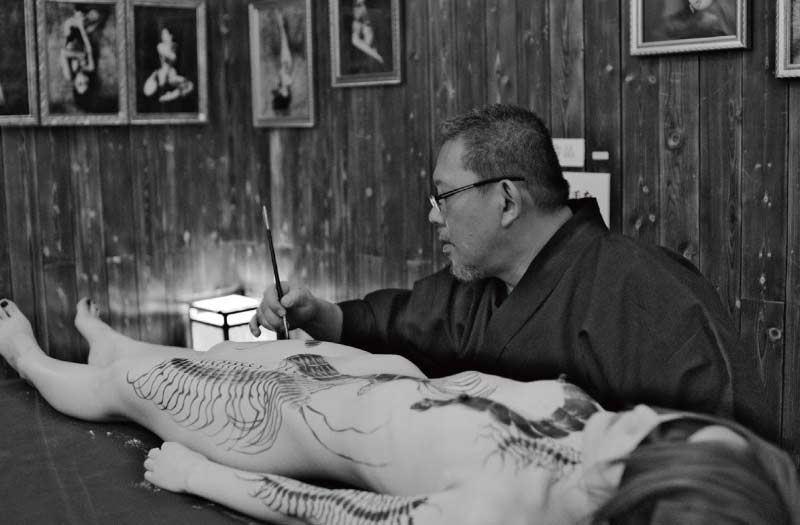
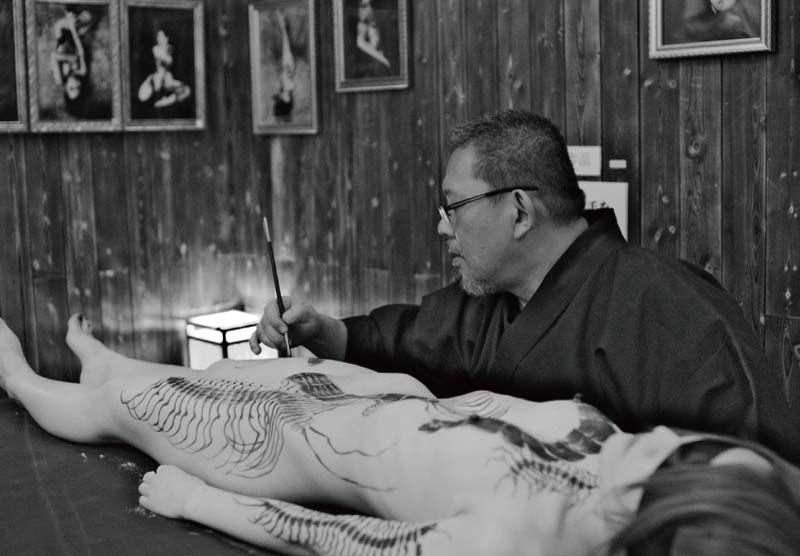


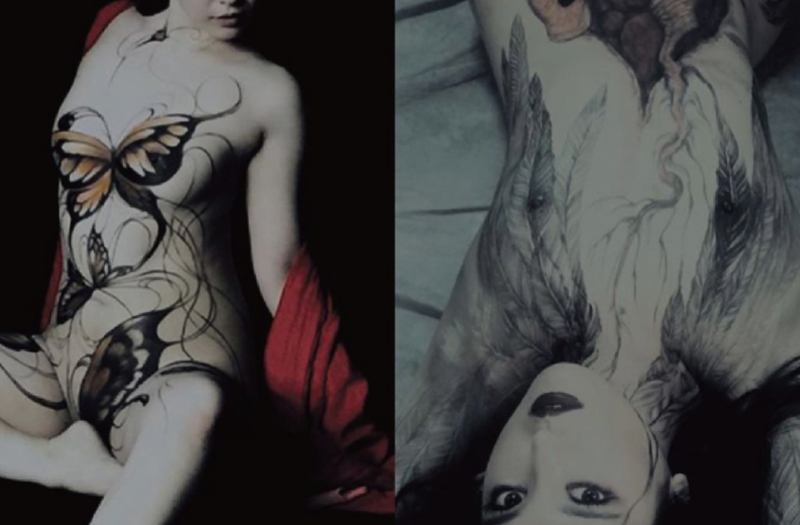
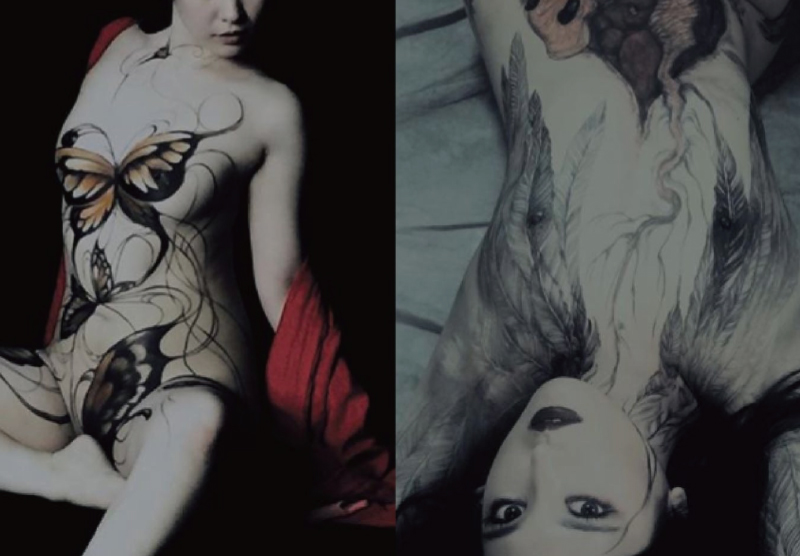


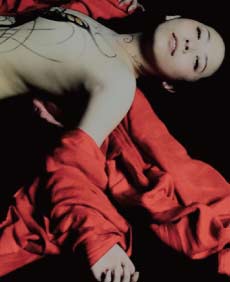
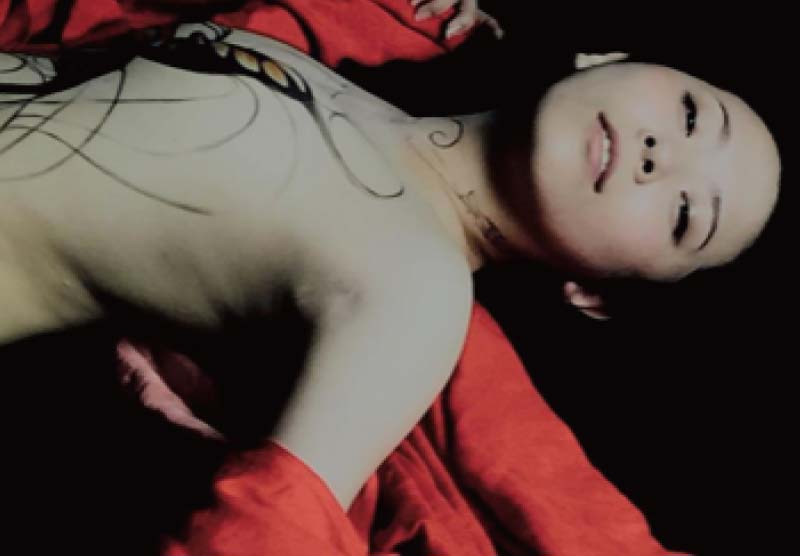



 PHOTO:Tadayuki Minamoto IKEBAHA:Atsunobu Katagiri
PHOTO:Tadayuki Minamoto IKEBAHA:Atsunobu Katagiri
